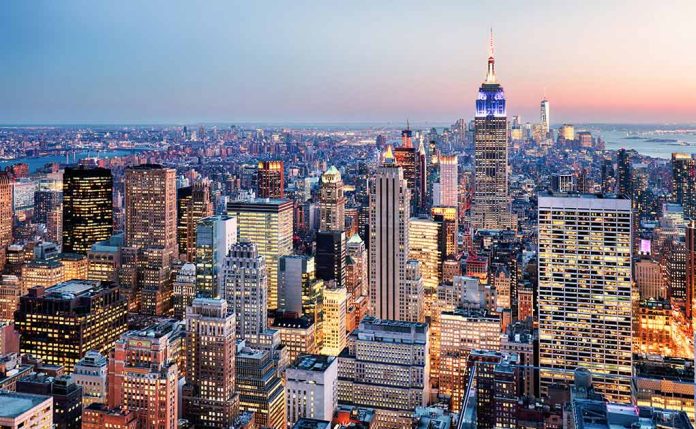
President Trump’s bold plan to transform Gaza into a “freedom zone” under U.S. control has sparked both support from Israel and resistance from Palestinians who refuse to abandon their homeland.
Key Takeaways
- President Trump proposed U.S. takeover of Gaza to transform it into a “freedom zone,” citing the territory’s near-complete destruction
- Israeli Prime Minister Netanyahu has called the plan “a bold vision” and supports the initiative to neutralize threats from Gaza
- Most Palestinians strongly oppose any relocation efforts, likening it to the 1948 “Nakba” displacement
- Trump’s vision includes rebuilding Gaza into a thriving tourist destination after addressing Hamas threats
- Arab nations have expressed resistance to accepting relocated Palestinian refugees
Trump’s Freedom Zone Vision
President Trump has unveiled an ambitious proposal to revitalize Gaza through direct U.S. involvement, presenting a solution to the devastated Palestinian territory. Speaking at a business roundtable in Qatar, Trump detailed his vision for American intervention in the region still reeling from the aftermath of the October 7, 2023 Hamas terrorist attack and subsequent Israeli military response. The plan centers on establishing U.S. control over Gaza to create economic opportunity and security in an area that has seen decades of conflict.
“I think I’d be proud to have the United States have it, take it, make it a freedom zone. Let some good things happen, put people in homes where they can be safe, and Hamas is going to have to be dealt with,” said Trump.
Trump’s assessment of Gaza’s current state is stark and unflinching. He has described the territory as essentially a “demolition site” with minimal intact infrastructure remaining. The president pointed to aerial reconnaissance showing widespread destruction throughout Gaza, with approximately 70% of buildings damaged or completely collapsed. This devastation forms the foundation of his argument that a complete redevelopment under American guidance is necessary.
Israeli Support and Palestinian Resistance
Israeli Prime Minister Benjamin Netanyahu has embraced Trump’s proposal, recognizing its alignment with Israel’s security objectives. “Israeli Prime Minister Benjamin Netanyahu has described Trump’s idea as ‘a bold vision,’ and has said that he and the U.S. president have discussed which countries might be willing to take Palestinians who leave Gaza,” Netanyahu stated, showing clear support for the initiative that would neutralize Hamas and other threats operating from Gaza.
The plan has faced significant opposition from Palestinians, however, who view it as an attempt to permanently displace them from their ancestral homeland. With Gaza’s population of 2.3 million already experiencing massive internal displacement due to the ongoing conflict, many Palestinians have expressed outrage at any suggestion of leaving their territory. Hamas official Basem Naim acknowledged Trump’s influence but maintained that “Gaza is not for sale” and remains an integral part of Palestinian land.
Rebuilding and Relocation Challenges
Trump has been direct about the impossibility of Gazans remaining in place during any reconstruction efforts. “I have aerial shots where, I mean, there’s practically no building standing,” Trump said, emphasizing the devastation. “It’s not like you’re trying to save something. There’s no building. People are living under the rubble of buildings that collapsed, which is not acceptable.”
“They’ve never solved the Gaza problem and if you look at it, I have aerial shots, I mean there’s practically no building standing, there’s no building. People are living under the rubble of buildings that collapsed, which is not acceptable, it’s a tremendous death. And I want to see that be a freedom zone,” said Trump.
The president has previously suggested relocating Palestinians to neighboring countries like Egypt and Jordan, which has been met with resistance from those nations. Arab allies in the Middle East have consistently expressed unwillingness to accommodate more Palestinian refugees, complicating the implementation of Trump’s vision. The relocation component remains one of the most controversial aspects of the plan, with critics comparing it to historical displacements of Palestinians.
Long-term Vision and Regional Impact
President Trump envisions long-term American ownership of Gaza as a stabilizing force for the Middle East. Beyond the immediate humanitarian concerns, his plan includes transforming the coastal territory into a thriving center for tourism and commerce. Trump has shared AI-generated videos depicting a luxurious, redeveloped “Trump Gaza” with modern infrastructure and amenities that stand in stark contrast to the current destruction.
“I’d be proud to have the United States have it, take it, make it a freedom zone,” stated Trump, highlighting his commitment to personal involvement in the transformation of Gaza. While ambitious in scope, the plan raises questions about implementation timelines, funding sources, and the political feasibility of such an unprecedented intervention. The proposal also represents a significant shift in American policy toward direct territorial involvement in the Israeli-Palestinian conflict.
With little progress in cease-fire negotiations between Hamas and Israel, Gaza’s immediate future remains uncertain. Trump’s freedom zone proposal has injected a new dimension into the debate over how to address the humanitarian crisis while ensuring regional security, though significant obstacles remain before any such vision could become reality.









